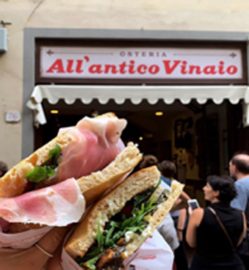First impressions on a Florentine foodie’s habits
 By Emily Boyer & Samantha Burkett
By Emily Boyer & Samantha Burkett
Florentine and Italian cuisine in general is known for its diversity at a geographical level, as well as it’s abundance of taste and seasonings, but its main characteristic is its simplicity. One thing that I’ve noticed about the dishes here is that chefs count on the quality of the ingredients that they use rather than the complexity of the preparation of their foods. I’ve also come to the realization that many of the city’s most traditional dishes are probably not exactly what we think they are. The Florentine people, like many Italians, have a very important relationship with their food. They seem to have very stern rules about what can be eaten when, with what to accompany certain foods, and in what particular order you can eat them. You can even tell what month of the year it is by looking at a menu in Florence. Florentine food is also very historical. Each dish seems to have a story behind it that reflects the long durations of the city’s traditions. There’s something about the fact that you can picture how many dishes were cooked in Medieval times, because it is indeed how they are still cooked and prepared today.
After just a few days in Florence, you will notice that they go by a very different food itinerary. First, it’s important to know that breakfast in Italy usually consists of baked goods and an espresso drink, which I’ve learned to get from a café where all of the pastries are baked on-site.
Italians also take part in what’s called a “merenda.” Around 12 pm they usually grab a snack at a local bar or food shop, with a coffee or even a glass of prosecco. This is something I feel like a lot of foreigners are not aware of, and that I found to be quite interesting. I think this is a quick and easy way to grab a snack during a work break or even while walking to and from class in the morning. As lunch time rolls around, many Italian may stop by one of the local food carts for the Florentine specialty of “lampredotto” which is prepared with the 4th stomach of a cow. Personally, I have not indulged in this delicacy, but a quick stop at a local panini stand can also serve the same purpose. 
After lunch, Italians may treat themselves to a mid-day gelato to hold themselves over until “aperitivo” comes around. Once 7 pm hits, Italians partake in this tradition, which is typically served buffet-style and a consists of a drink such as Florence’s signature negroni or a glass of prosecco and a few salty snacks such as chips or peanuts, with some cured meats & cheeses. Some locations will be even more formal with the aperitivo and set out some buffet-style foods, while other places might just offer appetizers from the menu to enjoy with their friends and family on the lovely streets of Florence. I have also just recently discovered at an aperitivo that sometimes the food consists of leftovers from that specific day’s lunch service.
Lastly, after the aperitivo comes dinner. For dinner, I think it is important to research what dishes to eat according to what time of the year you will be in Florence, as the dining culture revolves around the solar calendar. You can also ask the waiter what dish is currently in season.
I’ve come to learn that eating like a Florentine is luckily a very easy thing to do. The locals are proud of the way they eat and are determined to not lose their traditional eating habits to tourism. Maybe it’s obvious, but there is something comforting about knowing that no matter what happens or how much time passes, the Florentines are still going to be eating their beloved dishes.